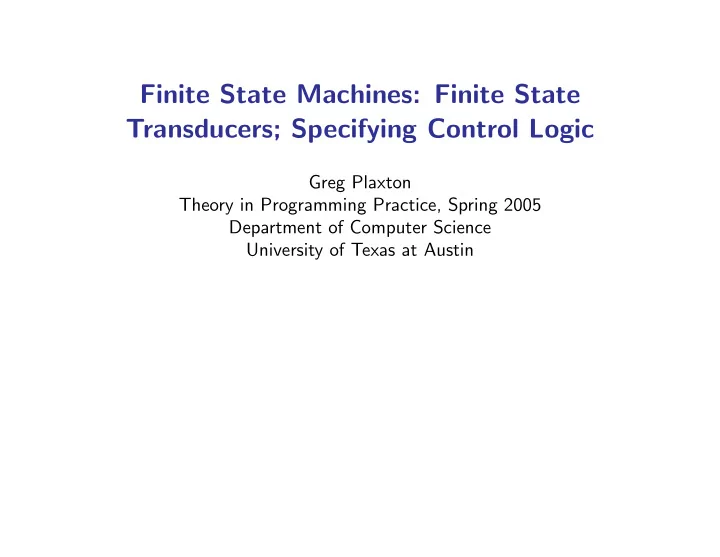

Finite State Machines: Finite State Transducers; Specifying Control Logic Greg Plaxton Theory in Programming Practice, Spring 2005 Department of Computer Science University of Texas at Austin
Finite State Transducers • A finite state transducer is a variant of the notion of a finite state machine • Recall that a finite state machine corresponds to a language, i.e., to the set of input strings that it accepts • A finite state transducer corresponds to a function from strings to strings – The output alphabet may be different than the input alphabet – Example: The function that maps each binary string to its complement Theory in Programming Practice, Plaxton, Spring 2005
Finite State Transducer: Definition • A finite state transducer is defined in the same way as an FSM except that: – In addition to the input alphabet, an output alphabet is specified – Typically there is no notion of acceptance of a string, so no accepting states are specified – Each transition has an associated output string (i.e., string over the output alphabet) • Like an FSM, a finite state transducer performs a particular sequence of transitions on a given input string – The output of the finite state transducer is the concatenation of the output strings associated with these transitions Theory in Programming Practice, Plaxton, Spring 2005
Finite State Transducer: Pictorial Representation • A finite state transducer is drawn in the same way as an FSM except that: – Typically there is no notion of acceptance of a string, so no state is designated as accepting – Each transition is marked with a symbol or set of symbols as in the case of an FSM, followed by a forward slash, followed by an output string Theory in Programming Practice, Plaxton, Spring 2005
Example: Serial Binary Adder • Input: Two nonnegative integers – Represented as equal-length binary strings – Presented as a sequence of pairs of bits – Low-order bit first • Output: Assuming the input strings are of length k , the output string is the k low-order bits of the sum of the input values – Low-order bit first • Draw a finite state transducer for solving this problem • How could we modify this problem slightly to ensure that the output string corresponds to the sum of the two input values, and not to just the low-order bits of the sum? Theory in Programming Practice, Plaxton, Spring 2005
Example: Parity Generator • Alice wants to send a sequence of 3 k bits to Bob • Each block of 3 bits should be followed by a parity bit for that block • Draw a finite state transducer that Alice can use to send the message • Draw a finite state machine that Bob can use to accept or reject each 4-bit block Theory in Programming Practice, Plaxton, Spring 2005
Example: Base Conversion • In each of the following cases, draw a finite state transducer that implements the desired function, or argue that no such finite state transducer exists: – Convert a binary string to base 4, assuming that the input value is specified low-order bit first – Convert a binary string to base 4, assuming that the input value is specified high-order bit first – Convert a binary string to base 3, assuming that the input value is specified low-order bit first Theory in Programming Practice, Plaxton, Spring 2005
Specifying Control Logic • A surprisingly wide range of systems can be modeled by finite state machines/transducers – In such cases, the finite state machine/transducer provides a precise description of the system behavior • Of course, many systems —even some relatively simple ones— cannot be modeled using only a finite number of states – In such cases, a finite state machine/transducer may still be useful for modeling some important part of the system, e.g., an “outer loop” of control logic Theory in Programming Practice, Plaxton, Spring 2005
Example: Soda Machine • We wish to model the following soda machine as a finite state transducer: – The machine accepts only nickels and dimes and dispenses two products, A and B , costing 15 and 20 cents, respectively – If the user presses the appropriate button (i.e., a for A and b for B ) after depositing at least the correct amount, the machine dispenses the item and returns change, if any, in nickels – If the user inserts additional coins after depositing 20 cents or more, the last coin is returned – If the user asks for an item before depositing the appropriate amount, a warning light flashes for 2 seconds – The user may cancel the transaction at any time, at which point the deposit, if any, is returned in nickels Theory in Programming Practice, Plaxton, Spring 2005
Recommend
More recommend